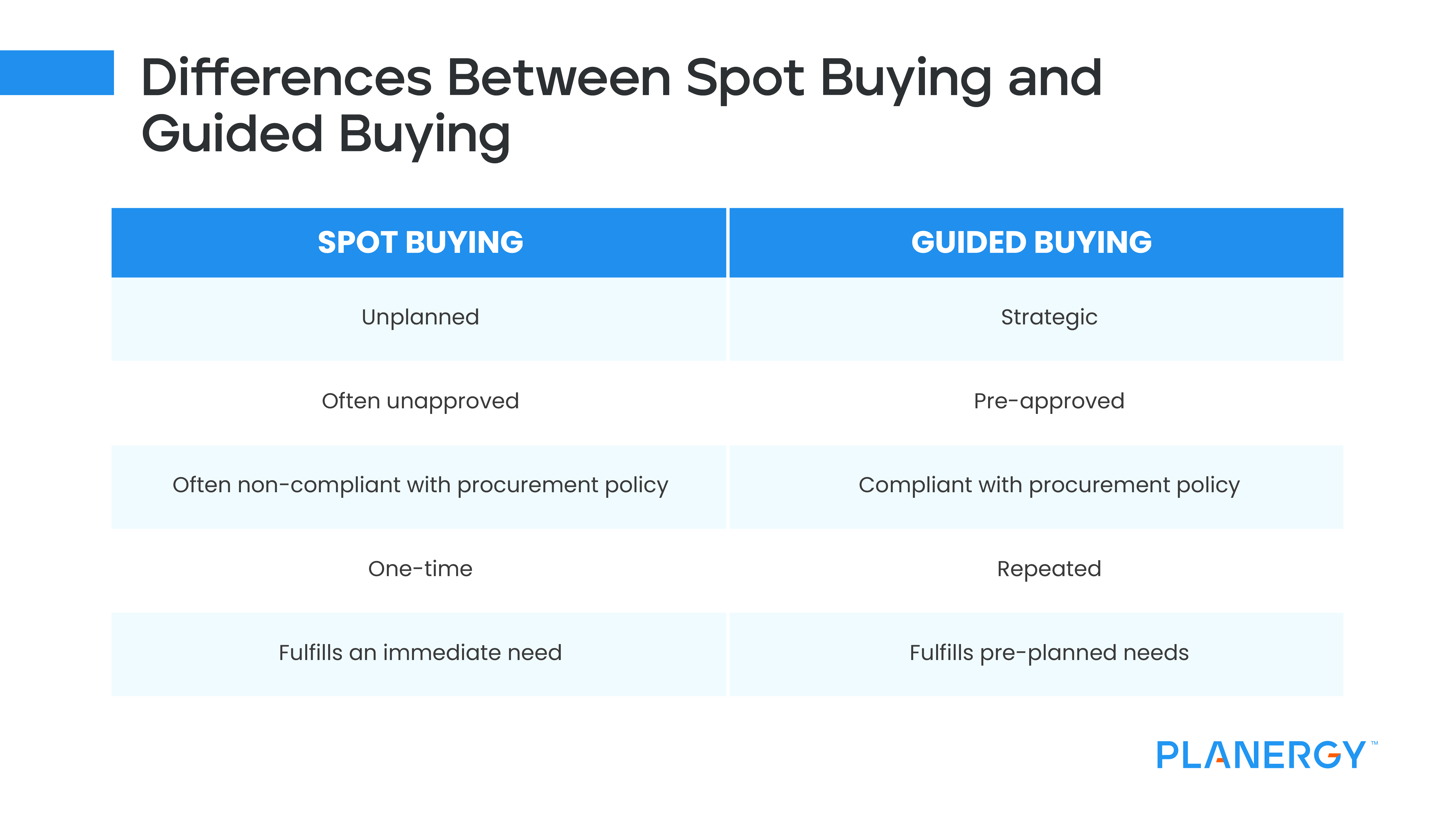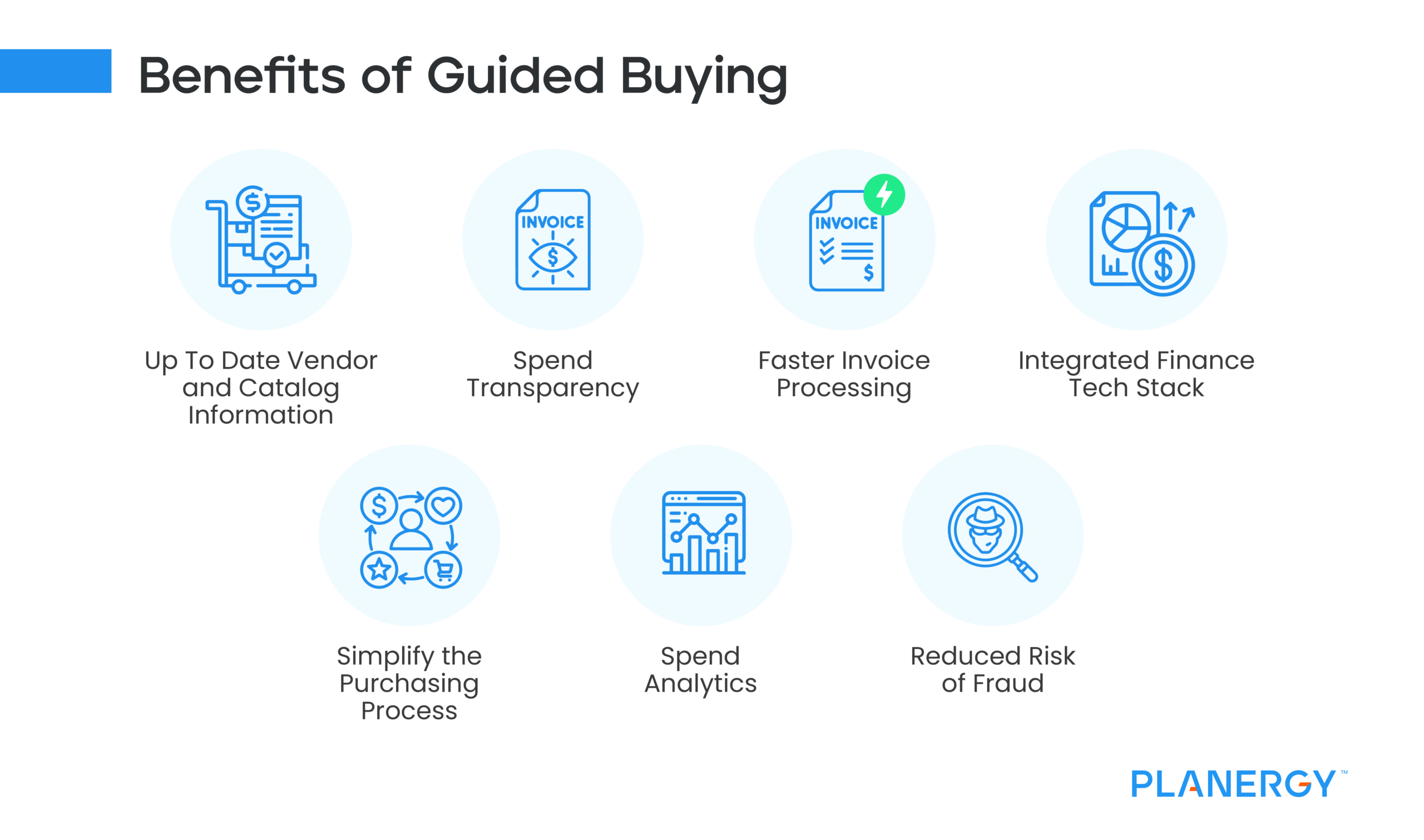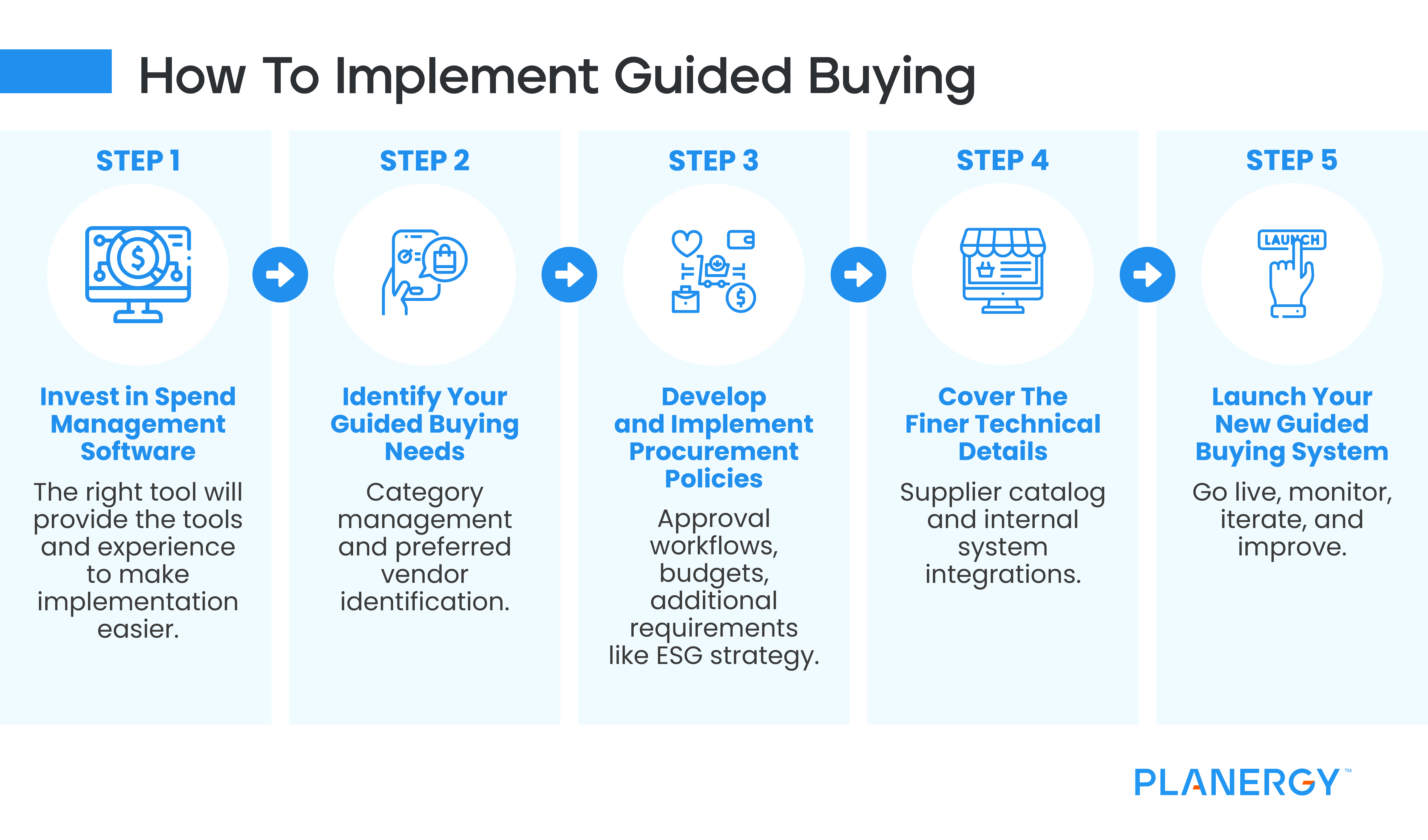The ideal procurement team focuses on delivering value for their organizations, as opposed to functioning as a back-room, savings-focused afterthought. Providing a guided buying solution is a powerful and highly-visible value creation strategy for procurement teams at any organization.
Guided buying improves procurement ROI and frees procurement teams to focus on strategic tasks rather than repetitive, tedious, and low-value ones. It also has the potential to help any business improve its overall spend management.
Understanding how to implement guided buying can help you to create a more efficient buying process while helping your business reach its goals.
What is Guided Buying?
Guided buying is a self-service company buying portal that limits the choices available to buyers and simplifies the buying process. It ensures that every purchase is made with preferred suppliers at the best possible pricing and terms.
It also enforces the company’s procurement policies and workflows without the purchaser needing to understand them or even know they exist.
Essentially, guided buying is an internal Amazon for company purchases. However, it’s limited only to the preferred suppliers and automatically enforces company purchasing policies and drives value from strategic sourcing initiatives.
It’s most often used on smaller, more repetitive purchases. Larger and more complex purchases are still carried out by the procurement team, often.
Even within guided buying, some organizations reserve purchasing capability to a select few within the procurement function itself. Others allow end users to access their purchasing systems to make budget- and role-appropriate purchases as needed.
A dedicated procure-to-pay software with granular controls, like PLANERGY, allow you to define exactly what an individual member of staff should be able to purchase and who should be required to approve their purchases following internal purchase order policy.
How Does Guided Buying Work?
Companies commonly implement guided buying as part of a procure-to-pay (P2P) software solution such as PLANERGY, which integrates with suppliers’ PunchOut catalogs. Various supplier catalogs are integrated into a single guided buying portal that can be used company-wide.
These digital catalogs are provided and maintained by suppliers, and can be integrated in two ways:
Directly through back-end integration with the company’s procurement software
Via a punch-out system that provides a stand-alone buying experience through a landing page hosted on the vendor’s servers—but is still integrated with the company’s procurement system.
Both provide a user experience with key features similar to eCommerce sites, with the familiar search functionality, shopping cart, etc. Choosing the right procurement software is key to setting up an effective guided buying experience. PLANERGY integrates with PunchOut catalogs and has an approved Amazon Business integration as part of the Amazon Business partner network.
Guided buying platforms pull pre-approved items from various supplier catalogs into a centralized self-service company purchasing portal. It enables both procurement and non-procurement team members to make purchases with greater speed and less complexity.
What Is the Difference Between Guided Buying and Spot Buying?
Spot buying is essentially the opposite of guided buying. It’s the act of making unplanned purchases, which are usually a one-time-only event. It’s often used during emergencies or for unique purchase situations that fall outside of normal business activities.
Spot buying also often happens on low-value purchases where employees want to forgo the typical sourcing and purchasing process to save time. Spot buying can also be a form of maverick spending. This type of ordering can introduce unexpected dangers, for example contradicting ESG procurement policies by ordering from non-compliant suppliers.
However, low-value spot buying purchases can add up over time and start to negatively impact the bottom line, especially if left unchecked by procurement teams.
Ideally, organizations can bring low-value purchases into their guided buying platforms so they can get transparency on all spend. Then, they can reserve spot buying only for unique and rare situations where it can’t be avoided.
(Graphic idea below)
Differences Between Spot Buying and Guided Buying
| Spot Buying | Guided Buying |
|---|---|
| Unplanned | Strategic |
| Often unapproved | Pre-approved |
| Often non-compliant with procurement policy | Compliant with procurement policy |
| One-time | Repeated |
| Fulfills an immediate need | Fulfills pre-planned needs |

What Are the Advantages of Guided Buying?
Guided buying is an essential tool for simplifying the buying process. Procurement specialists responsible for numerous tasks such as purchasing day-to-day essentials and supplier relationship management. Guided buying allows them to devote more time to high-level tasks that create long-term value for the business.
Guided buying platforms offer numerous benefits for the eProcurement process. They provide:
Up To Date Vendor and Catalog Information
Access to real-time vendor information, pricing, and payment terms from a single place.
Spend Transparency
Automatic tracking of all purchasing data, including the requisition, purchase order, and vendor order submission (including approvals where they’re required or pre-approval where they aren’t). Ensure all information is tracked and easily reportable.
Faster Invoice Processing
Streamlined invoicing that ensures all invoices are routed properly to accounts payable for verification against the approved purchase order, along with any receiving paperwork that comes with the order itself. If your procurement system includes AP Automation software this further enhances the process.
Integrated Finance Tech Stack
Integration with your accounting software, ERP, and other applications ensures you have a modern finance tech stack. This makes it easy to connect spend data with specific projects and budgets; and report on actual versus planned spend in real time.
Simplify the Purchasing Process
Reduce the need for specialized knowledge or sourcing events. Users get a streamlined buying experience while improving compliance with procurement policies and automation of purchase order approval workflows.
Spend Analytics
Improved spend management capabilities through complete, transparent spend data. Get better insights on your business spend through spend analysis to help empower strategic sourcing.
Reduced Risk of Fraud
A dedicated procure-to-pay solution incorporating guided buying will reduce the risk of maverick spend, as well as procurement fraud and invoice fraud.

How Does Guided Buying Support Strategic Sourcing?
Guided buying is highly supportive of strategic sourcing, which goes through multiple steps to vet for the best suppliers and deals. Once strategic sourcing has done it’s work and identified the best suppliers to use, guided buying ensures that employees only make purchases from those preferred suppliers.
In the guided buying portal, procurement teams can provide access to only the goods and services from the suppliers they have vetted through strategic sourcing initiatives. Guided buying limits choices to only the best suppliers and terms, supporting the decisions made during strategic sourcing.
How to Implement Guided Buying
If you’re looking to use guided buying to improve your procurement function, following a few simple best practices can help you get up and running. These are the steps we recommend going through when setting up a new guided buying system:
(Graphic idea: Visually represent these steps with a thoughtful design)
Invest in Spend Management Software
A comprehensive, cloud-based spend management software like PLANERGY makes it easy to set up a guided buying experience and provides automation tools to streamline processes. Your solution should help you achieve the following:
Set custom buying permissions with automatic routing and approvals based on type of order and order value.
Integrate with existing supplier PunchOut catalogs to develop your own landing page and user experience—with custom search functionality and buying channels created by your procurement team.
Real-time data collection that provides analysis for reports, forecasts, and budgets.
Transparent and complete data capture to help automate and refine other procure-to-pay tasks like automatic three-way match.
Useful technology that supports your digital transformation and business business process management.
Identify Your Guided Buying Needs
Before setting up a guided buying system, it’s important to understand exactly what you’ll need to set this system up. Carefully consider and list the following:
Identify the goods and services needed to meet both direct and indirect spending needs.
Develop buying categories for goods and services.
Identify the preferred suppliers, and backup suppliers where risk is identified, for every category.
Develop and Implement Procurement Policies
Once you’ve identified your needs, you’ll then need to create policies for guided buying that match your procurement needs. You’ll want to do the following:
Assign roles and budget levels as appropriate.
Integrate purchase justification where relevant.
Create tools to allow for exceptions with qualified approval.
Automate requests and data capture to prevent invisible spend.
Provide advanced options to request quotes or new suppliers in cases where goods or services are not already in the system.
Cover The Finer Technical Details
You’ll also need to make some key technical decisions and design choices for your new guided buying system. This step includes integrating with your preferred suppliers’ systems and designing your guided buying landing pages with your new procurement platform.
Decide whether you will integrate vendor data via an integrated punchout catalog or a discrete punchout website.
Design a buyer landing page that’s intuitive and user friendly. The purchasing software you invested in should help with this.
With the help of your purchasing software, provide a search function and as much relevant information as possible for each of the goods and services that should be available to purchase. If you are connecting users with a PunchOut website hosted by a vendor, ensure it meets these same requirements.
Launch Your New Guided Buying System
Once your guided buying system is integrated with vendors and ready to use, you’ll be ready to launch. Ideally, it will be an easy-to-use interface with a smooth new user adoption process, but you can always provide training and host internal meetings if necessary.
You will also want to have a change management plan to ensure the roll out is successful. Make sure that you spread internal awareness. Your procurement team can send out company-wide emails or record quick training webinars and share them.
They can also remind users who try to make basic purchases the old-fashioned way that ‘there’s a guided buying system for that’.
As you start to use the new system you will be able to start to collect spend data through your guided buying system.
As it builds up over time, you can analyze the data to reveal opportunities to renegotiate for better terms and pricing, strategic partnerships, etc. You can also use this data for spend management insights.

Guided Buying Transforms Procurement Into a Value Center
Your company needs goods and services fast. Your procurement department wants opportunities to use their skills to drive greater value for your business—and not get bogged down with a constant influx of small purchases. Guided buying provides both.
Guided buying frees your procurement team to work on supply chain management and other high-level procurement tasks. At the same time, it provides more visibility into your spending and gives end users a convenient, user-friendly way to procure the things they need to get their job done.




